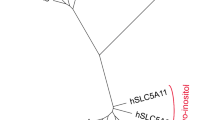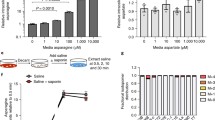Abstract
Background and aims
This study examined agmatine transport into six human intestinal tumor cell lines and compared the pharmacological properties of this transporter with those of the agmatine carrier previously characterized in human glioblastoma cells.
Methods
Carrier-mediated uptake was determined as specific accumulation of [14C]agmatine in the cells. The changes in intracellular agmatine concentration in the tumor cells after 24 h incubation with 1 mM agmatine was analyzed by high-performance liquid chromatography.
Results
Specific [14C]agmatine accumulation was found in the six human intestinal tumor cell lines Caco2, Cx1, Colo320, HT29, Colo205E, and SW480. Specific [14C]agmatine accumulation was inhibited by phentolamine, putrescine, spermine, clonidine, and decynium-22 but not by corticosterone, O-methylisoprenaline, or l-carnitine. Incubation with exogenous agmatine for 24 h increased intracellular agmatine content in all cell lines by a multiple of the basal endogenous content. Transfection of HEK293 cells with cDNA encoding either hOCT1, hOCT2, or hOCT3 did not enhance [14C]agmatine accumulation compared to nontransfected cells.
Conclusion
All intestinal tumor cell lines investigated express a functional specific agmatine transporter which exhibit pharmacological characteristics similar to those of the agmatine transporter in glioblastoma cells. This agmatine carrier is not identical with any so far known organic cation transport system.
Similar content being viewed by others
References
Molderings GJ (1997) Imidazoline receptors: basic knowledge, recent advances and future prospects for therapy and diagnosis. Drugs Future 22:757–772
Raasch W, Schäfer U, Chun J, Dominiak P (2001) Biological significance of agmatine, an endogenous ligand at imidazoline binding sites. Br J Pharmacol 133:755–780
Reis DJ, Regunathan S (1999) Agmatine: an endogenous ligand at imidazoline receptors is a novel neurotransmitter. Ann N Y Acad Sci 881:65–80
Molderings GJ, Menzel S, Kathmann M, Schlicker E, Göthert M (2000) Dual interaction of agmatine with the rat α2D-adrenoceptor: competitive antagonism and allosteric activation. Br J Pharmacol 130:1706–1712
Marton LJ, Pegg AE (1995) Polyamines as targets for therapeutic intervention. Annu Rev Pharmacol Toxicol 35:55–91
Jänne J, Pös H, Raina A (1978) Polyamines in rapid growth and cancer. Biochim Biophys Acta 473:241–293
Berdinskikh NK, Ignatenko NA, Zaletok SP, Ganina KP, Chorniy VA (1991) Ornithine decarboxylase activity and polyamine content in adenocarcinomas of human stomach and large intestine. Int J Cancer 47:496–498
Leveque J, Foucher F, Bansard JY, Havouis R, Grall JY, Moulinoux JP (2000) Polyamine profiles in tumor, normal tissue of the homologous breast, blood, and urine of breast cancer sufferers. Breast Cancer Res Treat 60:99–105
Rozhin J, Wilson P, Bull A, Nigro N (1984) Ornithine decarboxylase activity in rat and human colon. Cancer Res 44:3226–3230
Herrera-Ornelas L, Porter C, Pera P, Greco W, Petrelli N, Mittelman A (1987) A comparison of ornithine decarboxylase and S-adenosylmethionine decarboxylase activity in human large bowel mucosa, polyps and colorectal adenocarcinoma. J Surg Res 42:56–60
Porter C, Herrera-Ornelas L, Pera P, Petrelli N, Mittelman A (1987) Polyamine biosynthetic activity in normal and neoplastic human colorectal tissue. Cancer 60:1275–1281
Gökmen SS, Aygit AC, Ayhan MS, Yorulmaz F, Gülen S (2001) Significance of arginase and ornithine in malignant tumors of the human skin. J Lab Clin Med 137:340–344
d'Agostino L, Pignata S, Daniele B, d'Adamo G, Ferraro C, Silvestro G, Tagliaferri P, Contegiacomo A, Gentile R, Tritto G (1990) Polyamine uptake by human colon carcinoma cell line CaCo2. Digestion 46 [Suppl 2]:352–359
Til HP, Falke HE, Prinsen MK, Willems MI (1997) Acute and subacute toxicity of tyramine, spermidine, spermine, putrescine and cadaverine in rats. Food Chem Toxicol 35:337–348
Schipper RG, Deli G, Deloyer P, Lange WP, Schalken JA, Verhifstad AA (2000) Antitumor activity of polyamine analog N (1),N (11)-diethylnorspermine against human prostate carcinoma cells. Prostate 44:313–321
Raasch W, Schäfer U, Qadri F, Dominiak P (2002) Agmatine, an endogenous ligand at imidazoline binding sites, does not antagonize the clonidine-mediated blood pressure reaction. Br J Pharmacol 135:663–672
Satriano J, Blantz RC, Kelly CJ (1998) Methods of using agmatine to reduce intracellular polyamine levels and to inhibit inducible nitric. Patent WO9813037A1
Choi YS, Cho YD (1999) Effects of agmatine on polyamine metabolism and the growth of prostate tumor cells. J Biochem Mol Biol 32:173–180
Mates JM, Sanchez-Jimenez F, Lopez-Herrera J, de Castro IN (1991) Regulation by 1:4-diamines of the ornithine decarboxylase activity induced by ornithine in perifused tumor cells. Biochem Pharmacol 42:1045–1052
Satriano J, Matsufuji S, Murakami, Y, Lortie MJ, Schwartz D, Kelly CJ, Hayashi S, Blantz RC (1998) Agmatine suppresses proliferation by frameshift induction of antizyme and attenuation of cellular polyamine levels. J Biol Chem 273:15313–15316
Satriano J, Isome M, Casero RA, Thomson SC, Blantz RC (2001) Polyamine transport system mediates agmatine transport in mammalian cells. Am J Cell Physiol 281:C329–C334
Molderings GJ, Bönisch H, Göthert M, Brüss M (2001) Agmatine and putrescine uptake in the human glioma cell line SK-MG-1. Naunyn-Schmiedebergs Arch Pharmacol 363:671–679
Satriano J, Kelly CJ, Blantz RC (1999) An emerging role for agmatine. Kidney Int 56:1252–1253
Vargiu C, Cabella C, Belliardo S, Cravanzola C, Grillo MA, Colombatto S (1999) Agmatine modulates polyamine content in hepatocytes by inducing spermidine/spermine acetyltransferase. Eur J Biochem 259:933–938
Molderings GJ, Heinen A, Menzel S, Göthert M (2002) Exposure of rat isolated stomach and rats in vivo to [14C]agmatine: accumulation in the stomach wall and distribution in various tissues. Fundam Clin Pharmacol 16:219–225
Hayer-Zillgen M, Brüss M, Bönisch H (2002) Expression and pharmacological profile of the human organic cation transporters hOCT1, hOCT2 and hOCT3. Br J Pharmacol 136:829–836
Bradford MM (1976) A rapid and sensitive method for the quantitation of microgram quantities of protein utilizing the principle of protein-dye binding. Anal Biochem 72:248–254
Raasch W, Regunathan S, Li G, Reis DJ (1995) Agmatine, the bacterial amine, is widely distributed in mammalian tissues. Life Sci 56:2319–2330
Molderings GJ, Burian M, Homann J, Nilius M, Göthert M (1999) Potential relevance of agmatine as a virulence factor of Helicobacter pylori. Dig Dis Sci 44:2397–2404
Martel F, Gründemann D, Calhau C, Schömig E (2001) Apical uptake of organic cations by human intestinal Caco2-cells: putative involvement of ASF transporters. Naunyn-Schmiedebergs Arch Pharmacol 363:40–49
Osborne DL, Moshier JA, Gesell MS, Luk GD (1992) Polyamine uptake in tumorigenic and non-tumorigenic cell lines and the influence of extracellular putrescine on human colon cancer cells. In: Dowling RH, Fölsch UR (eds) Polyamines in the gastrointestinal tract. Kluwer, Dordrecht, pp 323–334
Cabella C, Gardini G, Corpillo D, Testore G, Bedino G, Solinas SP, Cravanzola C, Vargiu C, Grillo MA, Colombatto S (2001) Transport and metabolism of agmatine in rat hepatocyte cultures. Eur J Biochem 268:940–947
Babal P, Obson JW, Gillespie MN (1999) Agmatine suppresses polyamine transport in pulmonary artery smooth muscle cells. FASEB J 13:A827
Valle AE del, Paz JC, Sanchez-Jimenez F, Medina MA (2000) Agmatine uptake by cultured hamster kidney cells. Biochem Biophys Res Commun 280:307–311
Barendt WM, Wright SH (2002) The human organic cation transporter (hOCT2) recognizes the degree of substrate ionization. J Biol Chem 277:22491–22496
Tamai I, Ohashi R, Nezu J, Yabuuchi H, Oku A, Shimanes M, Sai Y, Tsuji A (1998) Molecular and functional identification of sodium ion-dependent, high affinity human carnitine transporter OCTN2. J Biol Chem 273:20378–20382
Wu X, Huang W, Prasad PD, Seth P, Rajan DP, Leibach FH, Chen J, Conway SJ, Ganapathy V (1999) Functional characteristics and tissue distribution pattern of organic cation transporter 2 (OCTN2), an organic cation/carnitine transporter. J Pharmacol Exp Ther 290:1482–1492
Acknowledgements
This study was supported by grants from the Deutsche Forschungsgemeinschaft and the Wilhelm-Sander-Stiftung. The technical assistance of Mrs. D. Funccius, Mrs. M. Hartwig, and Mrs. R. Müller is gratefully acknowledged.
Author information
Authors and Affiliations
Corresponding author
Rights and permissions
About this article
Cite this article
Heinen, A., Brüss, M., Bönisch, H. et al. Pharmacological characteristics of the specific transporter for the endogenous cell growth inhibitor agmatine in six tumor cell lines. Int J Colorectal Dis 18, 314–319 (2003). https://doi.org/10.1007/s00384-002-0466-8
Accepted:
Published:
Issue Date:
DOI: https://doi.org/10.1007/s00384-002-0466-8




